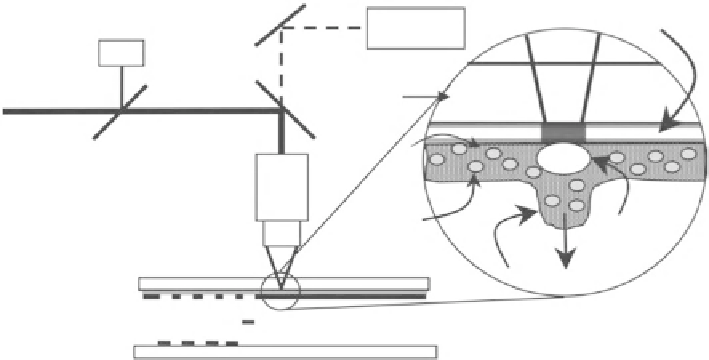Biomedical Engineering Reference
In-Depth Information
Laser Absorption Layer
Energy meter
CCD Camera
Support Layer
Laser
Biological
Layer
Microscope
Objective
Cells in Fluid
Biolayer
Material Transfer
Ribbon
Substrate
Fig. 9.9
Schematic illustration explaining the working principle of BioLP. A focussed laser beam
initiates material transfer towards the substrate. Interestingly, a laser absorption layer prevents
direct interaction between the laser and the biological materials. The scheme was reused from
[
277
] with the permission from Springer
methods have been described [
266,
268,
287,
291
]. In a post-processing step, the
construct is transferred to a bioreactor and the bio-ink spheres are fused. The
bio-paper, a hydrogel, can be removed after construction if required. Bio-printers can
either have a jet design or work like a mechanical extruder [
101,
293
] . This implies
that several RP apparatuses described in the previous part can serve as a bio-printer
(e.g. the Bioassembly Tool, 3D-Bioplotter™, …), if sterile conditions can be
acquired. In the case of inkjet technology, individual or small cell clusters are printed.
Despite the advantageous speed, versatility and cost, high cell densities are difficult
to obtain and considerable cell damage is induced [
266,
293
]. On the other hand,
extrusion-based bio-printers are more expensive but offer a more gentle approach
towards cells.
In this context, hydrogels are employed as bio-paper and only provide a tempo-
rary support for the deposited bio-ink particles. In other words, the bio-paper is
clearly different from scaffolds used in classical scaffold-based TE. In most cases,
this bio-paper hydrogel will have a sheet-like design (e.g. Fig.
9.10
). For instance,
Boland et al. [
294
] made use of thermo-sensitive gels to generate sequential layers
for cell printing. The group developed a cell printer, derived from commercially
available ink-jet printers [
295
], that enables to place cells in positions mimicking
their spatial location in an organ. The printer can put up to nine solutions of cells
or polymers into a specific place by the use of specially designed software, and
print two-dimensional tissue constructs. Extending this technology to three dimen-
sions is performed by the use of thermo-reversible gels. These gels were a fluid at
20°C and a gel above 32°C and serve as bio-paper on which tissue structures can
be printed. Dropping another layer of gel onto the already printed surface could
generate successive layers. The thermo-sensitive gel used for the experiments was

Search WWH ::

Custom Search